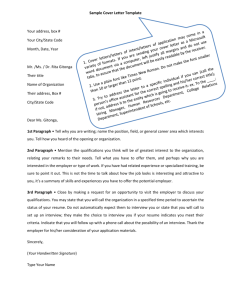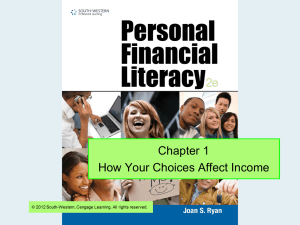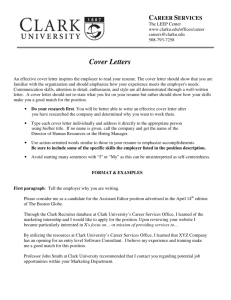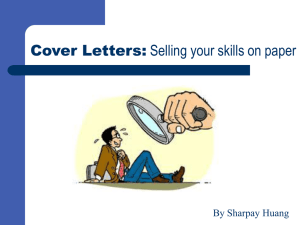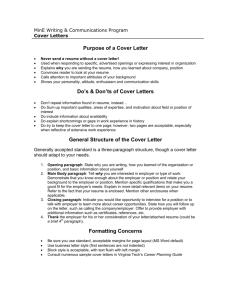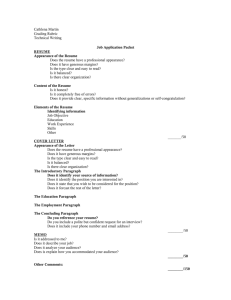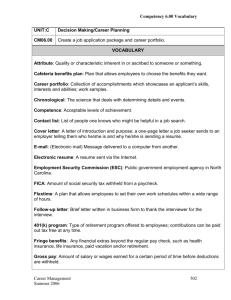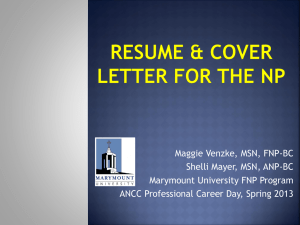Cover Letter Writing Workshop - University of Michigan School of
advertisement
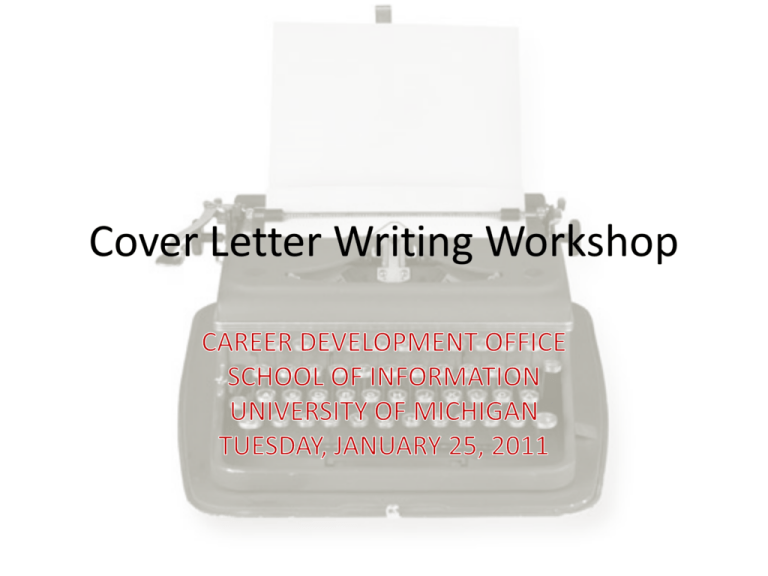
Cover Letter Writing Workshop Agenda • Formatting • Getting Started • Tips – Dos – Don’ts • Examples Formatting • Format your cover letter just like your resume: – Same margins – Same font – Same header, if applicable Getting Started 1. Find a position that you want to apply for 2. Read the position carefully, making note of the responsibilities and defined requirements 3. Think of scenarios when you have demonstrated the requirements – these can be transferable 4. Research the organization, making note of interesting facts or news 5. Write a rough outline of the cover letter Tips: Do! • Address your cover letter to someone – Pick a title or find a person’s name – Don’t address it to “Dear Sir or Madame” or the like • Tailor your cover letter to the job • Don’t be boring • Be personable; let them know that you are human and not a cover-letter generating machine (i.e. mail merge) Do! • Tell stories! • Respond directly to the position description • Share what you know about the organization – Go above and beyond what’s online – Read articles or talk to people about what’s going on in the organization • Try to keep your cover letter to one page • Name drop Do! • Use the relevant keywords and industry language – but don’t overdose on jargon • Because your resume will explain your technical and functional skills, use your cover letter to also promote soft skills • Be yourself • Know that your cover letter is a writing sample being inspected Do! • If you know who will be the recipient of the cover letter, look them up – Check LinkedIn – Search them to find out more about their background, interests, conference attendance, etc • Include or reference your LinkedIn Profile for more information, recommendations, etc • Explain why you are switching careers, or make note of large gaps in your employment history Tips: Don’t • Send generic cover letters • Be unprofessional or very casual • Not share why you are interested in the position and/or organization • Make the employer connection the dots between your experience and what they need • Have any grammatical errors • Write your letter in third person • Write a boring introduction Don’t! • Expect the employer to take action • Use clichés such as “Please find my resume enclosed” or “As you can see on my resume…” – Use this space to tell them things that they don’t know about you • Focus on coursework over work experience – If you only have coursework as relevant experience, that’s okay – just don’t minimize the things that gained from working First Paragraph The purpose of the first paragraph is to introduce yourself and tell why you are writing • I am writing you regarding the job posting for a position as a _______. OR • I have been referred to you by Professor John Doe at the University of Michigan School of Information. Include a relevant piece of current news or organizational information that will grab the reader’s attention Indicate why you are interested in the organization and the position of interest Provide a general statement about your qualifications for the position Don’t be dull! First Paragraph Example • Weak opening paragraph: – I am writing today to apply for the account manager position you have posted on your company Website • Better opening paragraph: – I have increased the size and sales levels of my client base in every position I have held, which in turn has increased the revenues and profits of my employers. I want to bring this same success to the account position you have posted on your Website. Real Example Dear Ms. Doe, I am very interested in pursing an internship position that will challenge my current concepts of design at a place where my non-traditional background will offer unique perspectives and contributions to group/team projects. From my previous work in music composition to my current work in interaction design, I always try to approach a problem in a clever and elegant manner, keeping the user’s experience at the forefront of my thoughts. I am looking to intern in a dynamic environment that complements this emphasis on creative thinking, originality, and usercentered design; I know TechSmith is that place. Real Example Dear Mr. Smith, I recently had the opportunity to speak with Steve Cotterill, Apple’s Experience Engineer in the Information Systems & Technology division, about the Human Interface Guidelines for the iPhone. We discussed how the implementation of intuitive design, fluid function, and necessity of ease in most, if not all, of Apple’s products has undoubtedly lead to their success and popularity. After discussing these guidelines and using my own iPhone religiously, I decided to explore internship opportunities with Apple. To my delight, I came across a posting for an Online Support User Experience Intern for the upcoming summer of 2008. I believe I would not be only an excellent fit for this position but also would bring a unique perspective into the discourse of User Experience Design at Apple. Second Paragraph Describe your qualifications for the position using specific examples from academic, work, volunteer and/or co-curricular experience Connect your accomplishments, skills, and knowledge directly to the position, organization, and/or field Stress accomplishments and achievements over your daily job duties Third Paragraph Continue building a case for your employment using specific examples Focus on personal qualities and special skills that enhance your qualifications Expand on your resume, but don’t repeat it (could also be a continuation of paragraph 2) Tell the employer how you can directly contribute to the company – again, don’t make them connect the dots Real Example I am currently in my first semester in the University of Michigan’s School of Information, studying Library and Information Services. In May of last year, I received my BA in French, graduating Summa Cum Laude and as a member of the Phi Beta Kappa Honors Society from the Catholic University of America. While I was a student there I worked at Mullen Library, the University Library, in several positions, including in the Interlibrary Loan Department. There I developed an interest in working with digital library resources, which has become a focus of my studies at the University of Michigan. Working at JSTOR would give me a greater understanding of these resources and perspective on how they are produced. Working in the Interlibrary Loan Department required me to work independently and in a detail oriented fashion. I was also responsible for communicating and addressing issues with other libraries, developing firm communication skills. It also familiarized me with library bibliographic information. I have also, more recently, used these skills as a Content Manager at the Internet Public Library. There I assist in evaluating, editing, and adding resources both in a database and in HTML format. Real Example Though it may seem like a great leap from music composition to HCI, the best HCI advice I ever received was from my composition professor when I was studying in Paris. I was struggling with a violin sonata and told my professor of this difficulty. He told me to get away from the piano and imagine myself in a packed concert hall waiting to hear this new piece of mine performed by a world famous performer. At that moment, when the music first starts, what would I most want to hear? What would make that moment special? That, he said, is what I should write. This approach of thinking about what would be the most special and perfect for the user/audience greatly informs the work I do in both classroom and professional settings. Music composition and HCI are rooted in finding creative and pleasurable solutions to audience expectations. While I am no longer a professional musician, I am still creatively designing for an audience. My work at the University of Michigan Health Systems, performing a contextual inquiry and web re-design, as well as at TechTransfer, researching the needs of different potential customers, were certainly enhanced by this mentality of understanding and respecting the needs and expectations of users. My experiences demonstrate that I am a dedicated and intelligent worker, willing to take challenges, and excited to learn. Moreover, I have a strong interest in creativity and in the creative process – in developing interesting and elegant solutions to complex problems. The unique perspective provided by living overseas as a scholar/composer/performer has given me a great deal of experience working with and directing groups. I have learned not only how to work effectively within these groups, but also I recognize the reward from doing so. Final Paragraph Give a final statement of interest/qualifications Offer information about your interests and availability, both for employment and for being contacted by the employer Indicate your plans to contact the employer to discuss opportunities or request an interview Don’t forget to include your contact information Thank the employer for his/her time and consideration Real Example I thank you for your time and consideration. I will be available starting from the beginning of September. You can contact me at xxxx@umich.edu or 555/555-5555. I am attaching my resume as well to give you information about my academic background and work experience. Also, you can see a brief overview and snapshots of my work at my online portfolio: http://www.abcdef.com Real Example Through the experiences I have discussed above and other experiences mentioned in my resume, I have come to value the importance of research as it relates to social justice, policy and politics. My community involvement and leadership roles have also solidified my passion to make a difference. In joining your organization, I believe I can contribute significantly through the Research Assistant position. Hard work and a willingness to learn and improve my expertise are qualities I am of the belief that I possess. I look forward to hearing from you and if you have questions, please feel free to contact me. Real Example User Experience development is an opportunity for me to connect with users and produce something that works not because they understand it, but because I understood them during product development. I know “how people work,” from both an anthropological and an accessibility standpoint, and by “Thinking Differently” about the user experience, I can greatly contribute to Apple’s Online Support User Experience team. Thank you for taking the time to consider me for a summer Internship with Apple. You are welcome to contact me either by phone or e‐mail. I will contact you in one week’s time to confirm that you have received my resume and cover letter. I look forward to future correspondences. Cold Cover Letters • Most positions are never advertised • A cold cover letter is an uninvited inquiry to an employer, recruiter or other hiring manager regarding possible job opportunities • Cold cover letters’ potential advantages include: – creating a job that didn’t previously exist – gaining early consideration for a position that hasn’t yet been advertised and expanding your network of contacts • By sending a letter to an employer who’s not soliciting candidates, your resume will not be buried in a pile of hundreds of others • You can also use a person’s name as a referral in a cold cover letter Real Example Dear Mr. Kotowski, I recently read a series of articles in the Wichita State Journal about the Kansas State University (KSU) Athletic Department. It was fascinating for a Wildcat fan and undergraduate alumnus such as myself to get such an in-depth look at the work and dedication it takes to run a major collegiate athletic department. In one of the articles, you mentioned to Athletic Director Rick Holland the need for a Digital Archivist at KSU. I was amazed and excited to see this statement. I recently completed my graduate education at the University of Michigan’s School of Information where I studied digital archiving and gained significant experience working with the athletics archives. Final Recommendation • Write your cover letter first as a personal essay – be personable, tell stories about yourself and your experiences and be sure to reflect your enthusiasm for both the department and the position • THEN, revise your resume to fit an expected cover letter format • Focus you letter on what you can do for them, NOT what they can do for you • Get several reviews from others to ensure that its professional, yet a reflection of you External Resources • Virginia Tech Career Services – http://www.career.vt.edu/JobSearchGuide/CoverL etterSamples.html • Quintessential Careers - Cover Letters – http://www.quintcareers.com/covres.html You can always have your cover letter reviewed by the SI-Career Development Office Staff. Email your cover letter to si.careers@umich.edu or contact us to make an appointment QUESTIONS?
